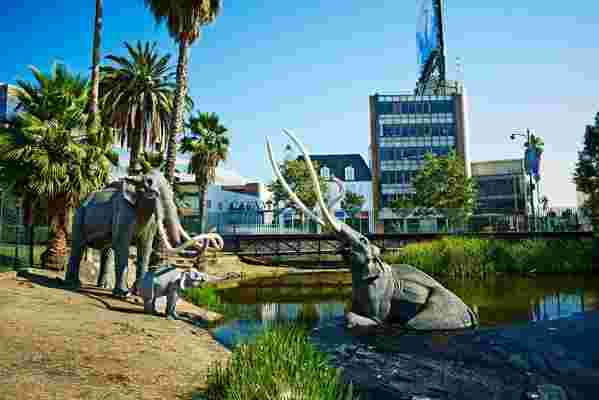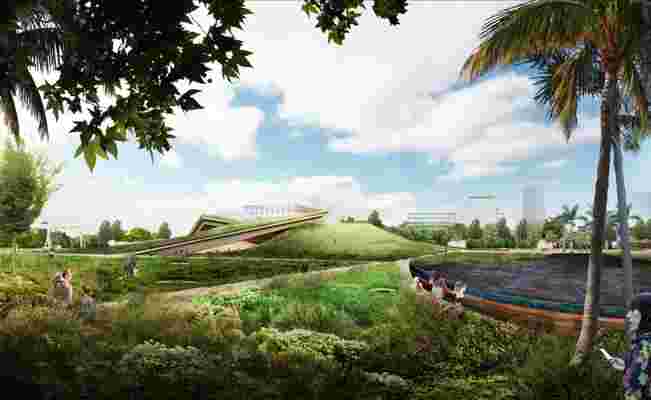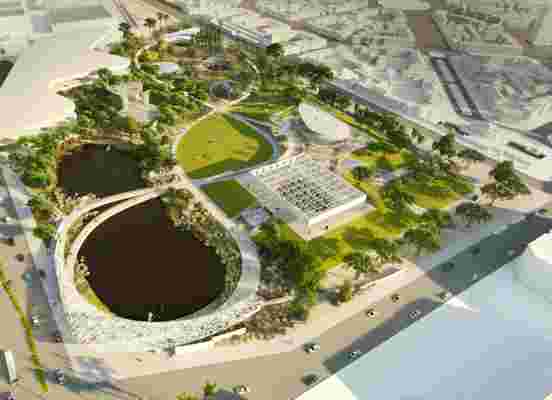Adjacent to the Los Angeles County Museum of Art, ancient tar has bubbled up into rainwater pools for centuries. And on the surrounding site, the bones of some of the largest Ice Age animals are plentiful. La Brea Tar Pits in Los Angeles has long been a hot spot for paleontological research and the science-curious visitor; it opened as a 12-acre park and natural history museum complex 40 years ago. Now its design is being reconsidered for the first time by a trio of international architects: Copenhagen-based Dorte Mandrup , and New York-based Diller Scofidio + Renfro and Weiss/Manfredi .

La Brea Tar Pits in Los Angeles has been reimagined by three international architecture teams to improve its accessibility, sustainability, and integration. Currently, a family of mammoth statues plays in the Lake Pit on the 12-acre site.
The Natural History Museums of Los Angeles County called upon the three design teams to reimagine the beloved site within L.A.'s Hancock Park—preserving its special features (namely, the tar pits), increasing visitor access, and introducing more sustainable infrastructure while better integrating the 1977 Page Museum and the landscape. Each team has "established expertise in integrating public green space with museum collections," which NHMLAC president and director Dr. Lori Bettison-Varga hopes will "help us see the site with fresh eyes." (After a public review process, the final design will be chosen in December.)

In a lush landscaped park, Diller Scofidio + Renfro envisions a new glass edge for Lake Pit to reveal its former life as an asphalt mine.
The approaches, however, are vastly different. Diller Scofidio + Renfro proposes a "light touch" for the Page Museum—a reevaluation of disused spaces within its existing footprint—while Weiss/Manfredi and Dorte Mandrup both see the need to build expansions to better serve visitors and reveal the connection between scientific research and the site.
"The La Brea Tar Pits is a site of unfolding paradoxes: a place of active excavation and science, a community park, and a museum of paleontology in a city continually reinventing the future," say principals Michael Manfredi and Marion Weiss of Weiss/Manfredi in a statement to AD . Replanning the site as a triple Möbius strip with a continuous pedestrian path and observation platforms over active digs, their design connects these so-called paradoxes. A circular expansion to the museum pops up above ground level (extending a path to an accessible rooftop platform) to spark passerby interest in artifact collections previously hidden underground. Its organic shape is perhaps a reference to the future Peter Zumthor–designed LACMA expansion, which was recently approved despite the architecture community's protests .

Weiss/Manfredi's "Loops and Lenses" master plan for the La Brea Tar Pits site includes a triple Möbius strip pedestrian path and an egg-shaped expansion to the 1977 Page Museum.
Dorte Mandrup, too, wants to bring the inside out, with significant changes to the museum itself. The team proposes expanding the structure vertically, lifting the through-floor foyer and redesigning it as a glass-clad circulation space with a series of bridges and stairs floating over the lower level; reproducing the exterior Pleistocene frieze as a solar screen; and adding a rooftop garden and bar. "It has been crucial for us to increase and improve the capacity of the existing building, while keeping the main characteristics of this unique museum and increasing the amount of green space accessible to the general public," says principal Mandrup. On the grounds, a series of boardwalks would weave through the living laboratory site and underscore its stories with new wayfinding.
In Dorte Mandrup's proposal, a glass-clad foyer in the vertically expanded Page Museum sparks interest and connects the institution to the parkland that serves as its living laboratory.
The only team that chose to forgo a physical extension of the museum, Diller Scofidio + Renfro focused instead on a plan that would increase parkland by 50,000 square feet. "As an urbanized culture, we are rarely conscious of the geological forces that shape the ground we walk (and drive) on," explains principal Liz Diller . Her plan aims to "engender a sense of responsibility toward the role humans play in shaping the environment they inherit," by introducing new open space for digs, research, and recreation as well as planting hundreds of new native trees in ecotones to reduce water use. The museum would receive a few tweaks to open it to this expanded landscape: Its symmetrical berms would be transformed into a forecourt of landscaped ramps that allow multiple entry points, and inside, its archives would be held in a glass volume to float with circulation in a reimagined lobby.
A new arrival plaza brings visitors to the tar pits and the Page Museum's new forecourt, landscaped ramps that announce the existing building, in Diller Scofidio + Renfro's master plan design for the La Brea Tar Pits in Los Angeles.
Beyond the site, Diller sees the La Brea Tar Pits revision as a catalyst for a revitalized Miracle Mile, the stretch of Wilshire Boulevard that was originally named for its rapid development due to car culture. "A revitalized Hancock Park is conceived to be the connective tissue between existing and new institutions, public spaces, and urban infrastructure," she says.
Whether neighborhood changes result only the future will tell. And because of the nature of master plan designs (and the public input process), the final vision for the site is malleable. What is certain is that Angelenos (and their beloved mammoth family statues) will soon see a new and improved home for this unique natural site within their highly urbanized city.
